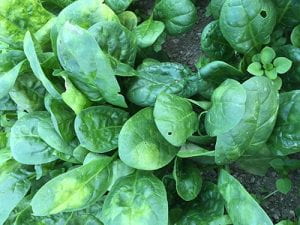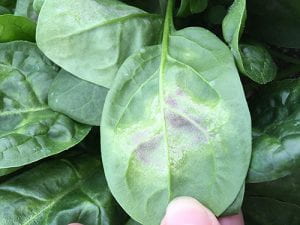Updated February, 2023.
This factsheet contains information on the following:
Additional Information:
- Transmission of spinach downy mildew via seed and infested leaf debris. (article published in Plant Disease in 2023; co-authored by M T McGrath).
- Spinach Downy Mildew: Advances in Our Understanding of the Disease Cycle and Prospects for Disease Management. (Feature article published in Plant Disease in 2019).
- Published Plant Disease Management Reports (PDMR) reports on evaluations of resistant varieties and biofungicides. (Click on ‘Search All Reports’ on left side of page and enter ‘spinach and downy’)
- PDMR: Varieties for resistance to spinach downy mildew in Arizona
- PDMR: Biofungicides and conventional fungicides for spinach downy mildew in Arizona 2015 | 2017
- Diseases Occurring in Winter Greens and their Management
- Results from Grower Survey about Diseases Occurring in Winter Greens including Spinach
Introduction
Downy mildew has been found in spinach on several farms in the northeastern U.S. since 2014. Prior to this there were no reports for about 15 years. This disease has been a major production constraint in California and Arizona. Pathogens causing downy mildew are Oomycetes and thus related to the late blight pathogen. They are similarly able to produce an abundance of wind-dispersed spores capable of moving long distances, do not need leaves to be wet to infect (high humidity is sufficient), and can devastate crops.
All growers with spinach should examine their plants routinely for symptoms of downy mildew. Inspect at least once a week or when row covers are removed with winter crops. There have been cases of symptoms being first observed during spring in high tunnels due either to conditions not being favorable until then for symptoms to develop or recent infection by wind-dispersed spores. There can be a long delay between infection and symptom appearance when conditions are unfavorable following infection. Downy mildew can seemingly explode overnight when conditions become favorable again.
If downy mildew is suspected, please contact your local extension specialist and send an e-mail to mtm3@cornell.edu. Knowledge about occurrences is critical for a regional approach to management based on all having a general awareness of occurrence in the region (as done with late blight). Disease knowledge is the foundation of a management program.
Symptoms
The causal agent of spinach downy mildew is Peronospora effusa (previously known as P. farinosa f. sp. spinaciae). Purplish-gray, fuzzy growth of the pathogen, which is usually on the underside of leaves, is diagnostic. (See images below and at the LIHREC photo gallery) Early morning is the best time to see as the growth (which is spores and the structures holding them) is produced overnight, and during the day spores are dispersed by air currents. On the top side of leaves, opposite where the growth develops, the leaf tissue will be yellow, initially dull becoming brighter and larger with time. Subsequently affected tissue will become dry and tan. If only leaf yellowing is seen, which could occur when humidity is low, put suspect leaves upside down on wet paper towel in a closed ziplock bag for a day. Keep the bag in the dark, such as inside a box, to further promote the pathogen if present to develop.
Management
- Resistant varieties have been an important management practice due to the high level of control provided, but the pathogen has proven adept at developing new races able to overcome host resistance. The most recent races described are 17 in 2018 and 18 plus 19 in 2021. Races 12, 14 and 15 plus a novel type were identified associated with recent cases (excel table; pdf table) in the northeast that were tested. Races 13, 16, and 17 were likely responsible for other occurrences of spinach downy mildew based on the varieties affected or not in the plantings.
- Minimize leaf wetness. Irrigate early in day when foliage will have ample time to dry before night. Use drip irrigation where feasible. When using row covers, do not place over wet plants. Some occurrences of downy mildew in high tunnels have been associated with covering spinach when leaves were wet from watering.
- To maximize success of control with fungicides, start early in disease development (preventive best), and apply weekly. Conventional fungicides for this disease include: Actigard, Aliette, Merivon, Orondis Ultra, QoI fungicides (Quadris, Reason, etc), Presidio, phosphorous acid fungicides (ProPhyt, etc.), Ranman, Revus, Ridomil Gold, and Tanos. Downy mildew is difficult to manage with organic fungicides based on experience of researchers and growers in AZ and CA (see 2015 report). Labeled products include copper, Actinovate, Double Nickel, LifeGard, Regalia, Oxidate, Trilogy, and Zonix. Copper is considered most effective, but based on few evaluations of organic products. Check REI and PHI when selecting conventional or organic fungicides to make sure fits production schedule.
- Note that while leaves are held in plastic bag after harvest, affected leaves may rot and new symptoms may develop, especially if there is residual moisture from washing.
- Promptly destroy spinach crop if symptoms continue to develop despite management practices or right after final harvest even if no downy mildew seen as infection could occur subsequently. It is important to control the amount of inoculum in the region to minimize opportunities for spread and keep downy mildew impact low.
- Rotate out of land where spinach was grown for at least 2-3 years. The pathogen can survive a few years in soil as oospores. Oospores can be produced when both mating types (equivalent of gender) of the pathogen are present together infecting a leaf. This spore type is the result of sexual reproduction. Oospores are not dispersed by wind as occurs with sporangia, which are the asexually-produced spores on the underside of leaves. Oospores also could be left behind in soil after planting contaminated seed.
Other Susceptible Plants
The pathogen, Peronospora effusa (previously known as P. farinosa f. sp. spinaciae), is only known to infect spinach. It is possible some related (Chenopodium) weed species are susceptible to some races. However, cross infection experiments conducted to date have not been successful: pathogen taken from spinach did not infect any weeds and pathogen from weeds did not infect spinach.
Pathogen Sources
Possible initial sources of the pathogen for the northeast region are wind-dispersed spores (sporangia) from affected crops outside the region, infected spinach produce from outside the region, or oospores on contaminated seed. Spinach with downy mildew has been observed for retail sale. Research in 2023 documented seedling with downy mildew developed from spinach seed with many viable oospores.
Favorable Conditions
Cool temperatures with long periods of leaf wetness or high humidity is favorable for disease development. Wet foliage is especially favorable. Optimal temperature range for this pathogen is 59 – 70 F. However, spores of the downy mildew pathogen have been observed on plants over a very wide temperature range, from freezing (frozen plants) to 118 F!
Images
Downy mildew affecting spinach in a high tunnel, courtesy of Teresa Rusinek. The first image is the top view of affected foliage, and the second image depicts the lower leaf surface. Additional photos are available at this photo gallery (LIHREC).


Please Note: Any reference to commercial products, trade or brand names is for information only; no endorsement is intended. The specific directions on fungicide labels must be adhered to — they supersede these recommendations, if there is a conflict. Check state registrations and labels for use restrictions.
More information/prepared by:
Margaret Tuttle McGrath
Associate Professor
Long Island Horticultural Research and Extension Center (LIHREC)
Plant Pathology and Plant-Microbe Biology Section
School of Integrative Plant Science
College of Agriculture and Life Sciences
Cornell University
mtm3@cornell.edu


